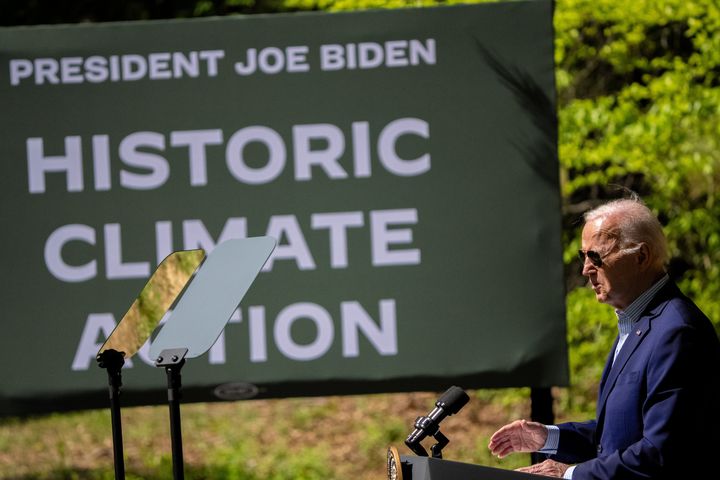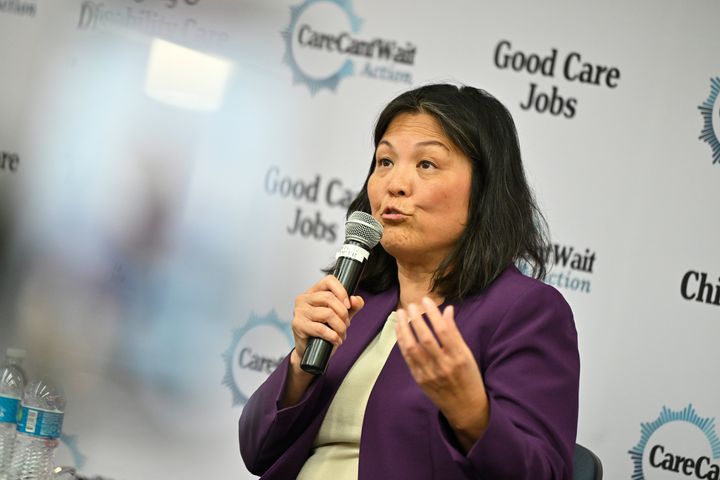This article is part of HuffPost’s biweekly politics newsletter. Click here to subscribe.
President Joe Biden may have just had one of the most productive weeks of his presidency, although it’s not clear how many Americans noticed ― or how many grasp what it says about the stakes of the November election.
In the span of less than five days, the Biden administration issued more than a half-dozen major regulations with the potential to affect many millions of Americans — and, arguably, the future of the planet as well.
None of these announcements came as a surprise. All of the new regulations are final versions of rules that have been in the works for years. The impetus for rolling them out this week is the calendar and a law called the Congressional Review Act, which gives Congress a few months’ time to rescind new rules the White House implements.
By issuing these new rules now, the Biden administration is protecting them from the Congress that takes office in January 2025 ― i.e., after the next election, when Republicans hostile to these regulations might gain control of both chambers.
But finalizing the rules now is still no guarantee they will stay on the books. If Donald Trump becomes president, he could issue new regulations that reverse Biden’s. The process would take some time, but it would be well within his powers. Biden did the same to many of Trump’s regulations upon taking office, just as Trump once did to Barack Obama’s.
Trump could also resume his project of packing the courts with conservatives on a mission to shrink the regulatory state. As it is, several of Biden’s new rules might not survive scrutiny from the Supreme Court, where a (now) 6-to-3 conservative majority has been hacking away at the executive branch’s leeway to make rules on everything from pollution to consumer safety. In a federal judiciary with even more Trump appointees, the rules would face even steeper odds.
All of which means the future of these new regulations depends on who wins the presidential election. But that’s not the only reason they should be part of voters’ calculus come November.
The new rules also say a lot about Biden’s priorities ― about the problems facing the American public, and how he thinks the federal government can help solve them. A second Biden term would presumably mean still more rules like the ones the administration announced this week.
Is that a good thing? A bad thing? Somewhere in between?
The answer depends on what you think about regulation in general, as well these new rules in particular. And it’s quite a list:
On Monday, the administration required nursing homes to meet new staffing standards. It also expanded health record privacy rules so they protect information about abortion.
On Tuesday, the administration made millions of new workers eligible for overtime pay and, separately, gave retirees new protections from predatory investment advice.
On Wednesday, the administration forced airlines to start issuing refunds for flight cancellations and long delays.
On Thursday, the administration announced new limits on power plant emissions and raised the energy efficiency standards for new homes. It also issued stronger nutrition requirements for the meals kids get at public schools.
Energy’s impact on the planet — and your bills at home
The power plant emission rules are among the most far-reaching, because they could play such a crucial role in efforts to slow global warming. As HuffPost’s Alexander Kaufman explains in his analysis, the new rules are designed to work in tandem with green energy subsidies from the Inflation Reduction Act, the sweeping climate law that Democrats passed and Biden signed in 2022:
Paired with the billions of dollars in carrots for manufacturing, building and buying modern energy equipment that came with President Joe Biden’s landmark climate-spending laws, the rules chart a path for the U.S. to avoid nearly 1.4 billion metric tons of carbon pollution through 2047. That’s equal to taking 328 million gasoline-fueled cars off the road or a full year of emissions from the U.S. electric power sector today.
The emission limits are part of a broader package that include rules streamlining the permitting process for transmission lines, reducing some of the red tape that’s made it difficult to build the grid infrastructure to increase the use of renewable energy.
The final version includes some concessions to utilities and other traditional opponents of emission regulations. Among other things, the emission rules apply to new natural gas plants but not to existing ones, following objections from utilities. But that doesn’t mean the critics are happy. Republicans and their allies have denounced the rules as job-killers, with officials from West Virginia, one of the nation’s top coal-producing states, leading the charge ― and promising lawsuits too.
“We will be challenging this rule,” vowed West Virginia Attorney General Patrick Morrisey.

As Alex notes in his article, administration officials think they’ve written the new rules in ways that can survive even the new, stricter tests for regulations the Supreme Court has laid out.
The same goes for another big new climate rule: a plan to raise the construction standards for new homes that qualify for federal housing loans. It sounds wonky, but as Alex details in a separate article, there’s huge amounts of money at stake. Every time extreme heat waves hit, demand for air conditioning spikes — and with energy prices have roller-coastered ever since Russia’s invasion of Ukraine, Americans’ outstanding debt to utility surged to a record of over $20 billion last year.
Like the power plant rule, the housing requirements have already drawn blowback from Republicans in Congress and could easily draw Trump’s attention in a second term, given his frequent attacks on anything associated with green energy.
When more work doesn’t mean more pay
Similar threats loom for the new overtime rules — which, as HuffPost’s Dave Jamieson explained this week, are designed to help low-income workers who haven’t been able to collect overtime pay because they’re salaried.
Most hourly workers are entitled to time-and-a-half pay when they log over 40 hours, which discourages employers from working them too much. But whether salaried workers can get overtime pay depends on how much they earn and what their job duties are. Employers have an incentive to pile work onto those without overtime protections, since the extra work is done essentially for free.
The current overtime salary threshold is just $35,568 ... Salaried workers, such as retail store managers, must earn less than that amount to automatically be entitled to any additional pay when they work more than 40 hours.
“This rule will restore the promise to workers that if you work more than 40 hours in a week, you should be paid more for that time,” Julie Su, acting Labor Secretary, said in a statement.
The new rules represent the second recent attempt by a Democratic administration to make more salaried workers eligible for overtime pay. Obama tried to do the same thing in 2016. Then a federal judge blocked the rule, and Trump later put in place the current, weaker standard.

Republicans haven’t jumped to oppose the overtime rules like they have the emission limits, perhaps because better pay for more workers sounds appealing even to many Republican voters.
But business groups to whom Republicans frequently listen have made clear they oppose these requirements, warning that they will force companies to raise prices, fire workers or shutter altogether — and that small businesses in particular will be vulnerable, because they are least able to absorb new costs.
Sean Kennedy, a spokesman for the National Restaurant Association, told CNN the new rules would “exponentially increase” costs for small establishments.
A Start On Nursing Home Reform
Critics of the Biden administration are also raising the specter of higher prices, layoffs and closures in response to the new nursing home regulations.
The rules set a minimum for the number of direct care staffers relative to the number of residents. Although the federal government has long required nursing homes to maintain adequate staff, this is the first time it has established a numerical standard.
The rule follows through on a promise Biden made in the 2022 State of the Union in response to media reports about poor conditions in nursing homes, especially during the pandemic, along with research linking staffing levels to patient well-being.
More than 80% of nursing homes do not meet the new standard, according to an analysis from the Kaiser Family Foundation, a nonpartisan health care research organization. Nursing home industry officials say the cost of adding staff will push some facilities past the brink of failure.
But advocates for senior citizens and other longtime proponents of nursing home care reform are skeptical of the industry’s arguments, citing widespread reports of how for-profit companies that own long-term care facilities use creative accounting to hide profits.
These advocates also point to evidence from states that have acted on their own.
“When states have adopted minimum staffing standards — and many states have them, Massachusetts has one, California too ― it hasn’t put nursing homes out of business,” David Grabowski, a Harvard health policy expert and longtime champion for nursing home care reform, said in a phone interview. “I do think there’s money in the system here.”
But advocates had pushed for even higher standards than the administration ultimately endorsed. And some, like Richard Mollot, executive director of the Long Term Care Community Coalition, said he worries nursing homes will interpret the new minimum as a maximum, creating a “race to the bottom” as better-staffed institutions lay off workers.
Others have questioned some of the regulation’s specifics, including the way it allocates hours among different types of direct care workers.
A Contrast In Priorities ― And On The Ballot
But among the longtime advocates for stronger nursing home regulation, even those concerned about the Biden rules remember what happened back when Trump was in charge. The agenda was very different.
“They cut back on enforcement [[of existing nursing home standards]], anything that Obama did, they pulled back,” Toby Edelman, senior policy attorney at the Center for Medicare Advocacy, told me .
And while there’s no way to know how aggressively the federal government would enforce these new rules if Biden gets a second term, Edelman said his focus on nursing home quality suggests these reforms are a big deal to him. “They are trying, the administration is trying,” she said.
You could say the same thing about Biden’s attention to workers ineligible for overtime, or to the climate dangers of dirty energy, or even to something as quotidian as the disruptions from canceled airline flights. Whatever the ultimate merits of these moves, as policy or law, they show Biden believes these are problems are worth addressing. It’s one more thing voters might want to consider in November.
Disclaimer: The copyright of this article belongs to the original author. Reposting this article is solely for the purpose of information dissemination and does not constitute any investment advice. If there is any infringement, please contact us immediately. We will make corrections or deletions as necessary. Thank you.
